How Much Space Do You Need for a Trampoline? (And How to Measure)
How much space do you really need for a trampoline? Learn why space requirements matter and how to measure your yard for safe bouncing!
min read
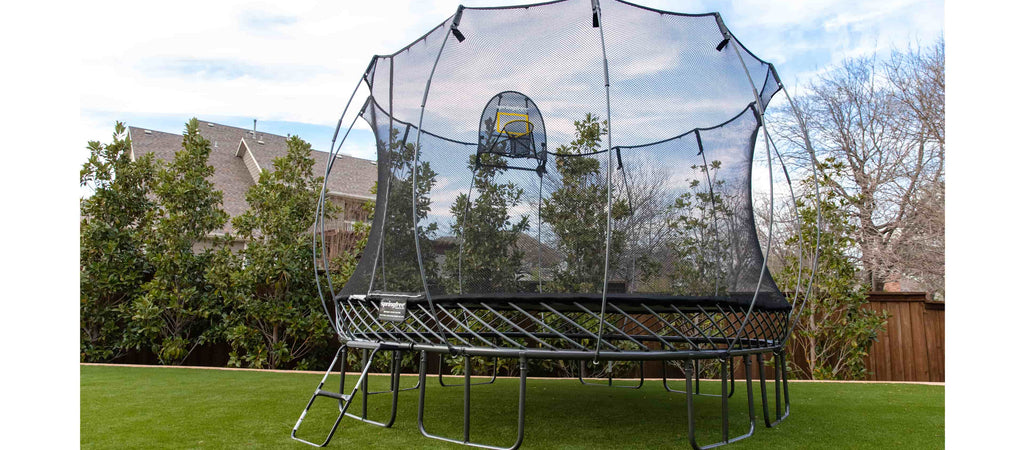
How much space do you need for a trampoline?
This question is crucial for the safety of your jumpers, and we get asked it a lot.
As trampoline safety experts, we will use our firsthand expertise to explain:
- Why having the right amount of space for a trampoline is so important.
- How much room to make for a trampoline (including clearance space).
- How to measure your yard for a trampoline.
Lots of ground to cover in this one. Let’s jump in.
Why It’s Important to Have Enough Space for a Trampoline
Before getting into specific trampoline space requirements, let’s discuss why they exist in the first place.
The main reason is safety.
If you don’t place your trampoline in a secure and spacious area, you increase your chances of a trampoline injury.
Obstacles around the trampoline, say a fence or tree, create a safety hazard.
Having the right amount of space ensures there is room for safe landings if somebody were to fall off the trampoline.
Other factors like easier installation, greater durability and a better bouncing experience also play a role.
What Are Trampoline Space Requirements?
The space you need for a trampoline will be based on your trampoline brand’s recommendations.
It’s also based on ASTM Standards (the leader in trampoline standards) which states that “lateral clearance space is essential,” and that the trampoline should be placed away from “walls, structures, fences and other play areas.
A trampoline’s space requirements will account for:
1. The trampoline’s size (dimensions, pictured below for our Springfree Jumbo Square Trampoline).
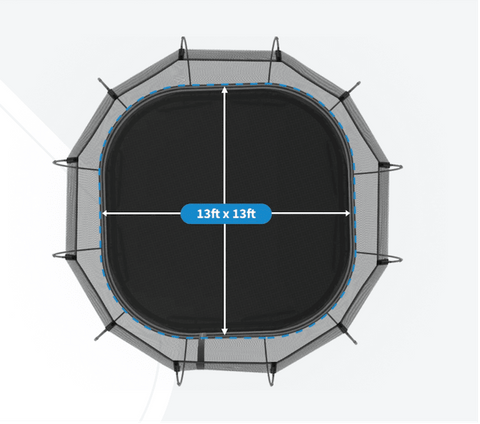
Springfree Trampoline.
2. The clearance space around the trampoline.
Why do you need clearance around a trampoline? Think of it like a buffer zone. If you fall off the trampoline, it ensures that you won’t land on a hard surrounding structure. That’s why manufacturers will list clearance space in addition to frame-to-frame dimensions.
Now how much clearance do you need around a trampoline? Manufacturers typically recommend 3-5 ft of clearance space for a trampoline.
For overhead clearance, a minimum of 24 ft from ground level is recommended, according to ASTM F2225.
Here’s a visual of what that looks like:
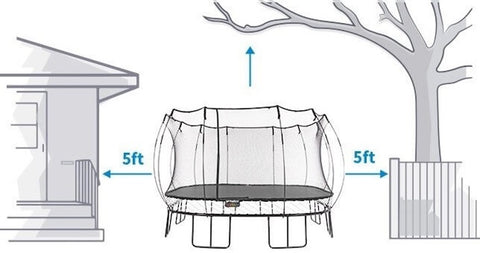
Springfree Trampoline.
While there’s no law saying you must follow the clearance space recommendations, think of it as a requirement.
It’s THAT important to safety.
How to Measure for a Trampoline (Step-by-Step)
Now that you know the why and what behind the space needed for a trampoline, it’s time to bring out the tape measure.
We’re going to tell you exactly how to measure space for a trampoline.
Step 1: Find a spot in your backyard that is flat and even. Make sure it’s clear of branches, debris, fences and slopes.
Note: If the space isn’t flat, make sure the rise/gradient is no more than three degrees across the whole space.
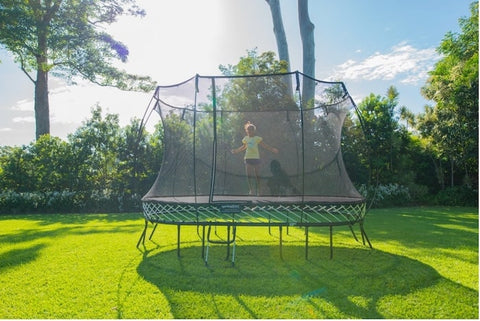
Springfree Trampoline.
Step 2: Take note of the trampoline’s dimensions and clearance space requirements. This should be listed online in the specifications of your trampoline or your installation instructions (if you already bought one).
Step 3: Grab that handy tape measure and measure the length and width of the area.
Alternative: We’ve seen customers use a garden hose to measure as well. You can lay it out in the shape of a trampoline to get an idea of how it would look in your yard.
Step 4: Finalize measurements and confirm that it meets the space requirements.
If it does not meet the space requirements, try to find another spot, and follow the same process.
5 Key Things to Know When Measuring for a Trampoline
Here are some other things to keep in mind when measuring for a trampoline and choosing the right spot:
1. Not all trampolines are created equal. A basic spring-based trampoline with static poles won’t need the same amount of space as a Springfree Trampoline.
2. The trampoline shape is also important. Some trampolines (like round and oval shapes) can fit in a narrow space. Square and rectangular trampolines may require more of a longer/wider space.
Example of a square trampoline properly placed in a backyard:
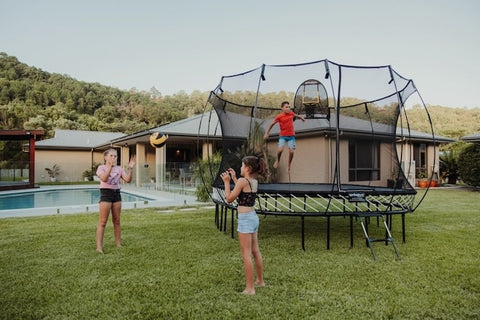
Springfree Trampoline.
3. If your child is an aspiring future professional gymnast, you may want to make more room than somebody using it just for fun.
4. Consider future landscaping ideas when choosing a spot. Moving a trampoline can be tough!
Tip: Trampoline wheels can be purchased to transport the trampoline more easily if you think you may need to move it in the future.
5. Ultimately, the spot you choose for your trampoline is your decision. If you’re comfortable with a spot, then go with it. We would highly advise you to follow all space requirements, however.
FAQ: How Much Space Do You Need for a Trampoline?
Now, let’s get to some common questions about the space needed for a trampoline.
In this section, you’ll find examples of space requirements for different sizes of trampolines. We’ll also address questions about specific structures.
1. What Is the Minimum Clearance for a Trampoline?
While there’s no standard minimum clearance for a trampoline, a good baseline to follow is 3-5 ft of clearance space on all sides.
Make sure to check your manufacturer’s guidelines on your trampoline’s space requirements.
2. How Much Space Do You Need for a 10 ft Trampoline?
For a 10 ft trampoline, like our Springfree Medium Round Trampoline, a safe clearance space to aim for is 20 ft x 20 ft of room.
If you have a spring-based trampoline, you might be fine with 16 ft x 16 ft of room. Always check with your manufacturer first.
3. How Much Space Do You Need for a 12 ft Trampoline?
For a 12 ft trampoline, it would be ideal to make 22 ft x 22 ft of space for optimal safety.
However, the brand, shape and type of trampoline will dictate the space you should follow.
4. How Much Room Do You Need for a 14-foot Trampoline?
A 14-foot trampoline will take up a lot of room. If you add 5 ft of clearance space to each side of the trampoline, you’re looking at space requirements of 24 ft x 24 ft. Again, though, this can differ depending on the type of trampoline you have.
5. How Far Away from a Wall Should a Trampoline Be?
Based on our expertise, we recommend placing a trampoline at least 5 ft from a wall. At the very least, aim for 3 ft.
6. Can You Put a Trampoline Next to a Fence?
You can put a trampoline next to a fence, but we recommend it be at least 3-5 ft away from the fence.
Also, if you have a trampoline basketball hoop, place it away from the fence. That way your child won’t have to get it if it goes over the fence!
What Size Trampoline Do You Actually Need?
We can’t overstate the importance of space requirements on trampolines.
They are foundational to follow if you want your jumpers to be as safe as possible.
But there are other aspects to choosing the right trampoline size besides finding one that fits your yard.
There are a couple of other essential size factors that you need to consider.
They can literally make or break your purchase.
Check out our article on what size trampoline you need so you buy the right size the first time around!

